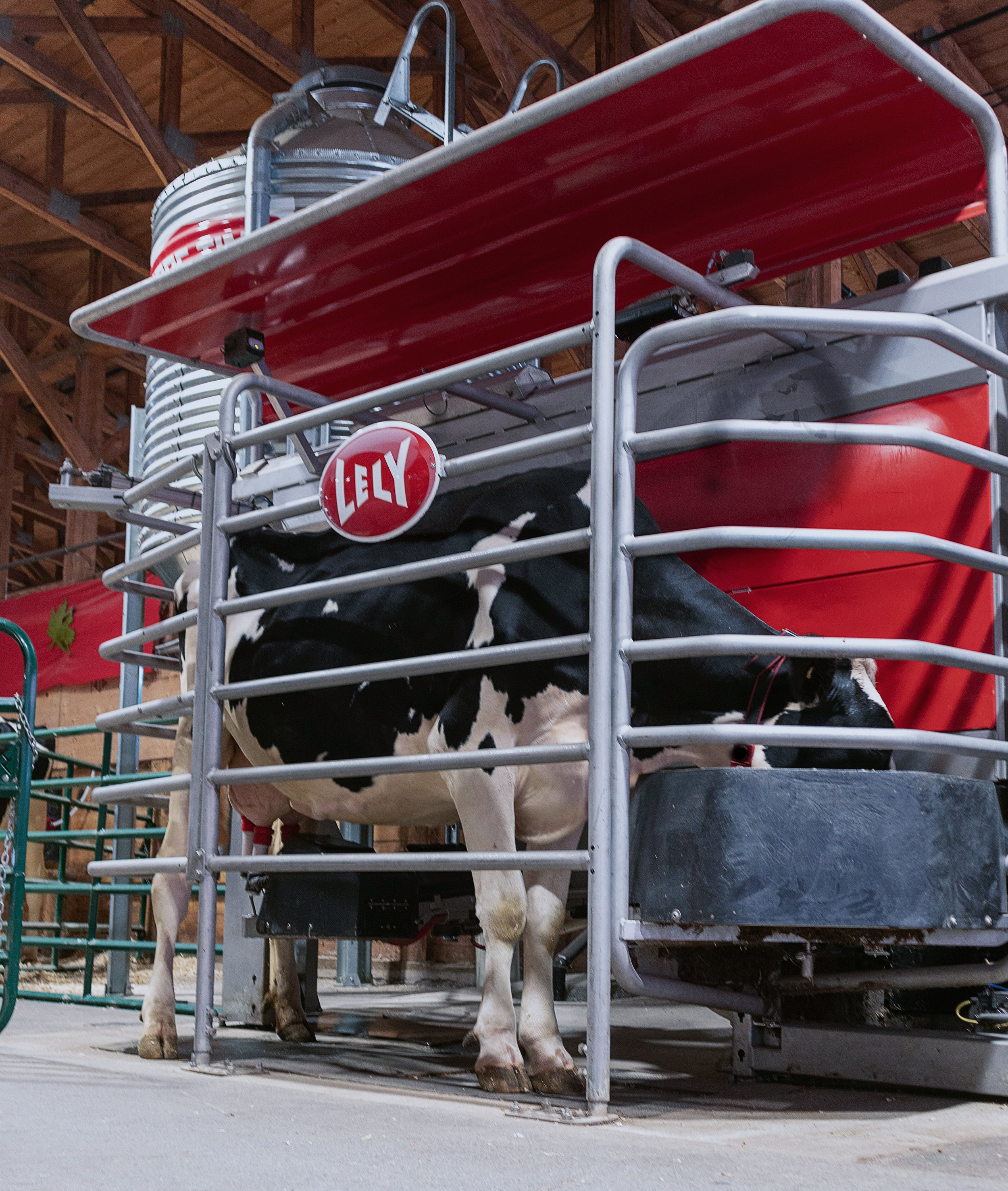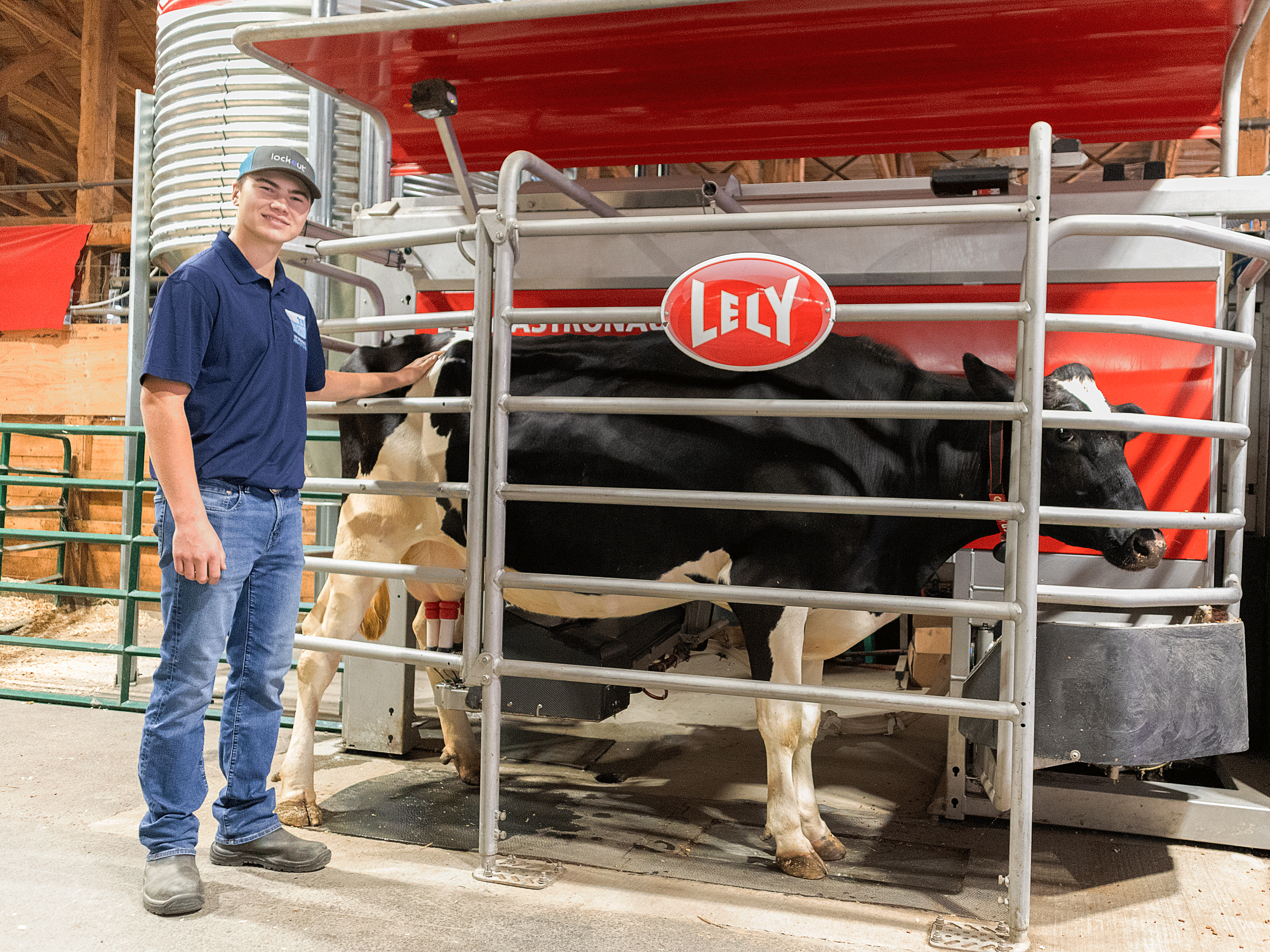words by Inda Intiar / photos by Haqq Brice
Automation and the lives of farmers and their cows
Translation by Georgette LeBlanc
Wanda Schuttenbeld's cow at the NBEX
It’s no secret that dairy farming is hard work. Farmer Wanda Schuttenbeld’s days used to include milking cows in the parlour of her family farm in Maugerville, NB.
“We'd go to the barn, we'd have to catch all the cows, put them in a corral, put a gate down, and all these cows would be standing there waiting to be milked. It was at six in the morning, six at night.”
There are 110 cows on her farm—60 produce milk. Each milking time takes two to three hours. Some days, they had to have staff to help them. But in 2012, when she and her husband saw other local farmers introducing automation, they decided to follow suit. They installed a Lely milking robot, which has brought a much-needed work-life balance.
“Our youngest son Harri was in competitive sports. We could never get to the soccer games, we could never get to the hockey games,” she explains.
After installing the robot, “we got to see all the hockey and soccer games, and attend the tournaments. One of us could stay home and manage the farm because of the milking robot.”
Wanda brought three cows from their farm to showcase the Lely robot at this year’s NBEX, the New Brunswick Provincial Exhibition. The NBEX’s mandate includes showcasing the province’s agriculture sector to the public.
The Lely is a Dutch innovation that allows cows to decide when it's time to be milked. This system has made Wanda’s cows happier and as a result, produce more milk.
“The cows love it. They never have to be pushed to go milking,” Wanda explains. “They drink when they want to drink water. They eat at the feed alley when they want to eat. They lay down when they want to lay down, go outside when they want and socialize when they want. And when they want to go get milked, they go to the robot.”
Every milk cow on their farm is equipped with a collar that has a transponder. When a cow enters the system, the robot recognizes that individual cow. It stores each cow’s information, from birth date to the number of calves she had. The robot knows what phase of lactation the cow is in, how much feed she needs, and how many times a day she can get milked.
“The robot knows if she’s in heat, if she’s eating enough grain, her milk temperature, if she has lost weight, and her rumination. It’s like having a veterinarian in your barn.”
The Lely robot sends the milk to a cooler tank where it’s stored. That milk is picked up every second day by trucks, transporting it for processing at Northumberland Dairies or Dairytown.

Wanda Schuttenbeld and her cow at the NBEX

Industry impact
Automation could bring some relief to the wider dairy farming industry as it supplies a growing population across Canada.
As workers and skills shortages go, agriculture is one sector already experiencing a dire shortage. The labour gap is expected to widen, with 100,000 jobs in the sector projected to be vacant by 2030 according to the 2023 labour market report by the Canadian Agricultural Human Resource Council.
Wanda’s lucky that her son Harri has interest in taking over the family farm. But for farmers who might not have a succession plan, or cannot find staff, automation can help.
“The actual physical milking is difficult and very time consuming, never mind interruptive to the cow’s natural activities. With automated milking, it has allowed people to stay farming longer if they’re not able to have someone take over their farm,” Wanda says.
Around 1 in 5 farms in Canada are using robotic milking systems, according to Statistics Canada’s 2021 census on technologies used in agriculture.
Karen Versloot, a dairy farmer from Keswick Ridge, NB, who sits on the board of Hosltein’s Canada, is noticing other technological trends in the sector.
Genomics testing and access to more detailed genetic information are helping farmers breed cows that can live longer and produce more milk.
“That's helping our carbon footprint because even though the population is growing and we still have to make enough to feed the whole country, we don't need as many cows to do that anymore.”
In the future, Karen expects cameras and AI to support the work of classifiers, who help farmers understand how to improve cow genetics so that the animals can live longer.
In the 30 years she’s been a farmer, Karen has seen “leaps and bounds” of change.
“I don't know if we've reached that threshold of how much milk a cow can make. I think we're getting pretty close to the maximum that a cow can make.”
“We have cameras where we watch the cows’ activities, keep an eye on the calving pens and the cow traffic to make sure the equipment is operating properly. In dairy farming there still needs to be someone in the barn, there are still many chores, feeding calves, scraping beds, sawdusting, feeding, cleaning, running scrapers. Every dairy farming operation is different. Automated milking doesn’t replace all the work, but it’s a huge help for sure.” Wanda reflects. “I’m not sure where we can go from here. I think we’re in a good situation for the animals and the farmers at this time.”
Even with all of the new technology, most farms have remained family-owned, with a focus on the cows’ comfort and health.
“Most dairy farmers are like that, it’s all about the cow. You want to make them happy and they'll make you happy by producing quality milk,” said Wanda.
Wanda’s son Harri and his partner Anna have just had a new baby. The automation on their farm is allowing them to enjoy this phase of their life. It also makes dairy farming more attractive as they gear up to take over the farm in the future. 🐄

Harri Schuttenbeld at the NBEX
This piece can be found in Winter 2025, Edible Maritimes #13
Inda Intiar is a writer, storyteller, and facilitator who brings a global perspective from growing up across multiple countries. Inda loves travelling, and trying new experiences and flavours. / Inda Intiar est une écrivaine, une conteuse, une personne connectée et une facilitatrice qui apporte une perspective mondiale en ayant grandi dans de plusieurs pays. Inda adore voyager et essayer de nouvelles expériences et saveurs. @firenationexplores
Haqq Brice is a photographer and multidisciplinary artist based in Moncton, whose art and creativity are used to express his vision. / Haqq Brice est un photographe et artiste multidisciplinaire basé à Moncton qui exprime sa vision à travers son art et sa créativité.
Georgette LeBlanc is a writer and translator. She is currently a sessional instructor of creative writing at l’Université de Moncton. / Georgette LeBlanc est écrivaine et traductrice. Elle est chargée de cours à l’Université de Moncton où elle enseigne la création littéraire.
Thank you for reading! If you would like more early access to our stories in digital format we encourage you to consider becoming a member. Learn more about our membership plans click the button below.

